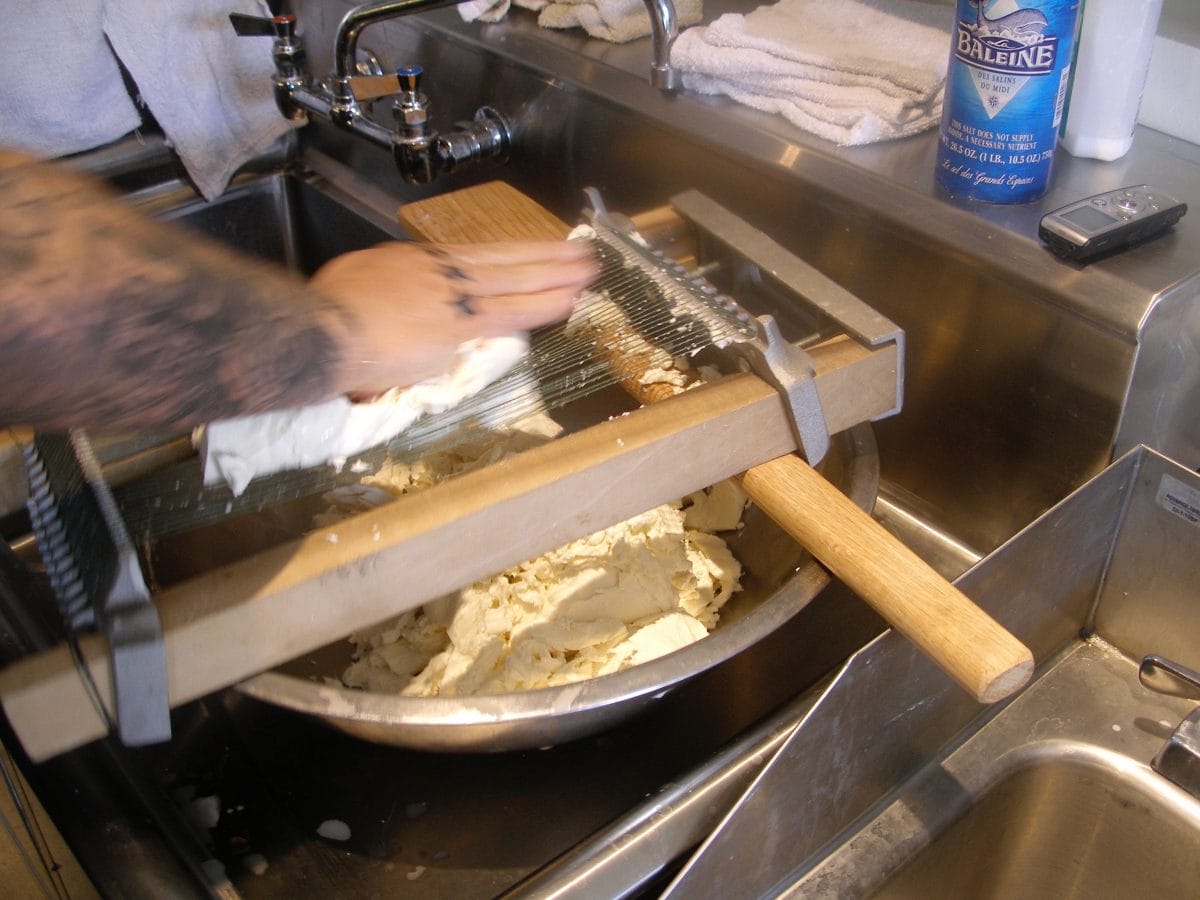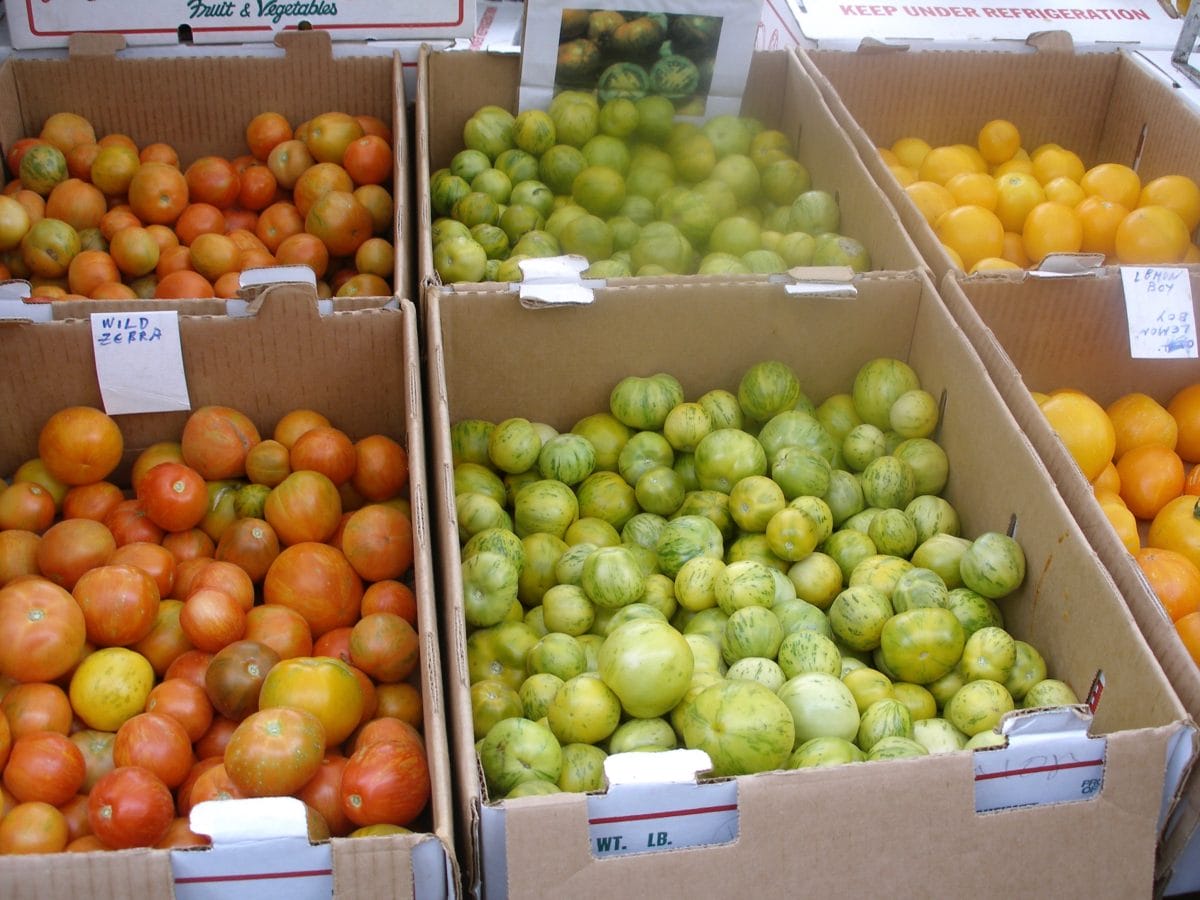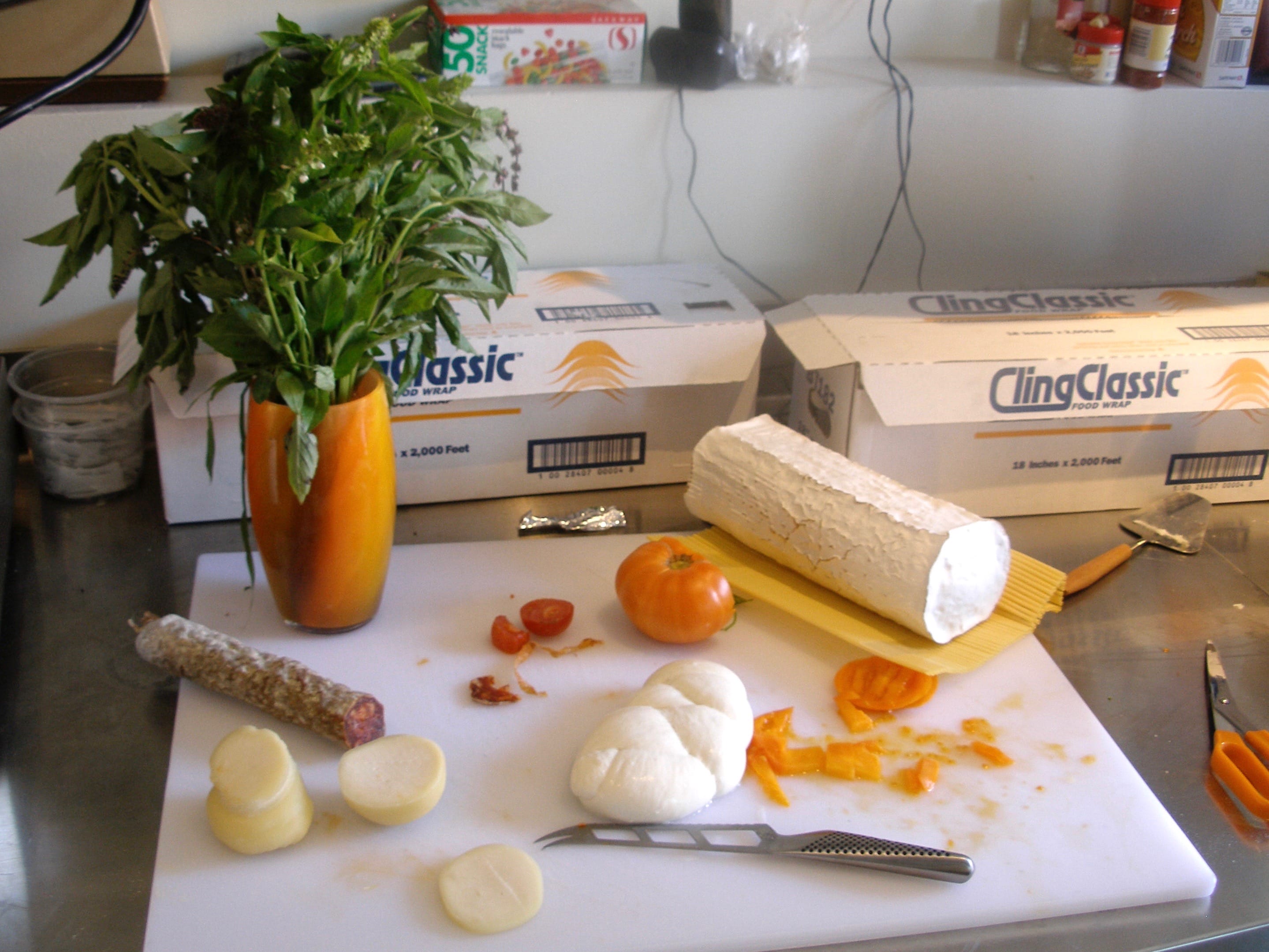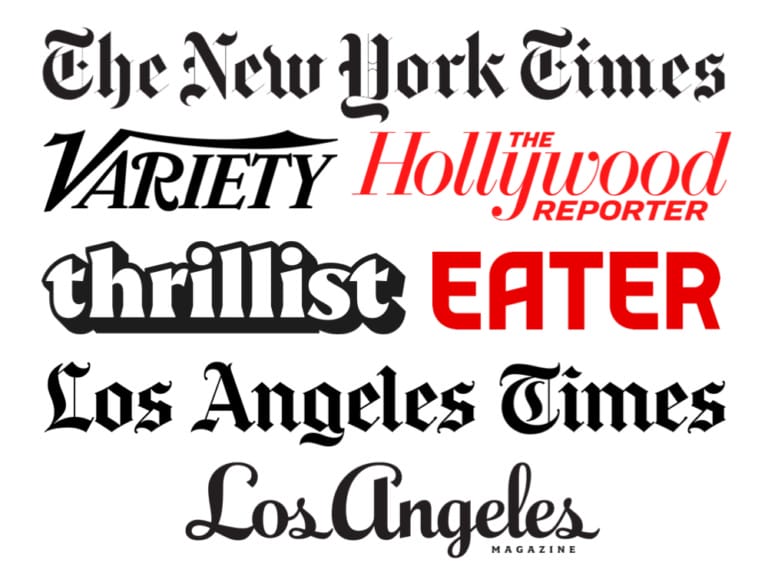Every Wednesday morning is “Mozzarella Madness” at Andrew’s Cheese Shop, a new Santa Monica destination from Patina’s former Maitre Fromager Andrew Steiner, who traded a marble cheese cart for blue jeans.
To make the mozzarella, Steiner recruited 23-year-year-old chef Tommy Pollio, a New Jersey native who relocated to L.A. for the weather, skateboarding, and to work in restaurants. He spent six months at French 75 in Century City before joining Eric Greenspan (and Steiner) at The Foundry on Melrose, where he is now sous chef.
Pollio may very well come by cheesemaking honestly. The chef shares a last name with Polly-O founder Giuseppe Pollio, whose family also comes from Italy’s Sorrento Peninsula. They’re probably related, but aren’t connected.
At Andrew’s Cheese Shop, Pollio makes fresh mozzarella in-store with curds from Caseificio Gioia in El Monte, a well-known company that also supplies Italian cheeses and burrata to some of L.A.’s best restaurants.
Pollio starts with 10-pound boxes of curd, the solid byproduct of cooking cow’s milk that remains after disposing of the liquid whey. His goal is to make 30 pounds of mozzarella today.

Tommy Pollio pushes curds through a hand-made “mozzarella guitar.”
Pollio set up his “mozzarella guitar” over a stainless steel bowl that conducts heat well. Some “guitars” are available commercially, but this version made with high-test fishing wire comes from Pollio’s friend and mozzarella mentor Sergio Sciancalepore, who he used to work for at an Italian specialty store called Sergio & Co. in Denville, New Jersey. For people who don’t have mozzarella guitars – most of us – Pollio recommends slicing the mozzarella into a quarter-inch thick strips.
Pollio pushes the curds through the guitar wire so they form even pieces. At this point, the curds are right out of the fridge, so Pollio brings them to room temperature before adding hot water. “If you were going to put boiling water on, it wouldn’t separate and it would be impossible to make cheese,” he says. “Pour the water out and add more hot water. Constantly bring the temperature up.” Add hot water until the bowl reaches room temperature.
“If it gets too hot, a lot of times, it’ll melt too rapidly and you won’t be able to work it,” Pollio says. “You’ll see, it’s almost melting in my hands. Sometimes you can’t work fast enough. If it’s melting too fast, it’s not going to be good…It’s not like a normal recipe, where ten minutes you do this, or five minutes you do this. It’s just a skill that’s learned. It has to be taught. Being shown, making mistakes, tasting it and seeing what you can do.”
Pollio had a crash course with Sergio. They made mountains of mozzarella. “Christmas Eve was always our busiest day of the year,” he says. “We’d start making mozzarella the day before to have enough.” In that case, they produced 1,500 pounds by hand.
The chef returns to making cheese. “You can see the mozzarella starting to melt together here,” he says. “You can see how it slowly moves. This isn’t something to work real hard. I’m not going to work it hard or knead it.”
“The mozzarella, you want it to be able to melt evenly,” he says. “Moving it around is really important because it will allow the curd to be a consistent temperature. After that, drain off with the water into a colander, then repeat the same process again. Add more water, then let the mozzarella relax a little bit. You don’t have to touch it right away. Let it sit in the hot water for a few minutes…It’s really about feel. That’s what mozzarella’s all about. It’s something you have to play around a little bit, to have fun with. I finally dump the water out and add water two or three more times. Then you’re definitely going to see the mozzarella is going to start to melt together. It’s naturally ebullient and it comes as a solid mass. At that point, you can either use a paddle or a spoon like I have here. You can use your hands, as long as you’re careful, and as long as the water’s not too hot to put your hands in. It’s almost like kneading dough in a sense. You want to be very gentle and very light. It’s really letting the mozzarella come together. The more that you use your hands and knead it a little bit, the texture of the mozzarella gets smoother. As it gets smoother, you get it to the desired consistency. If you overwork it, you’ll see some of the skin will break.”
He pinches off a piece of cheese. “You can do any size you want,” he says, “depends on how big a piece you want to make. Generally we do about one-pound braids here…The braid is more for [aesthetics] than anything. It doesn’t really affect the taste of mozzarella, but it’s part of the skill of making mozzarella.”
“You can either form it into a ball or a log,” Pollio says. “Usually for sandwiches, I’d probably make it into logs, so you can slice it and it’d be solid round pieces. You can use this (points to braids) for sandwiches as well, but if you’re somewhere where you’re constantly making sandwiches, it would make more sense, and be more consistent, to have round pieces. You can slice it on a meat slicer.”
He estimates that it takes 5-10 minutes to make one pound of mozzarella. Larger batches take longer since they melt at a slower pace.

Tommy Pollio’s braided mozzarella rests in a warm water bath.
People just need curds and water to make mozzarella. “Some people like to add salt to the water,” Pollio says. “That’s fine. I prefer a salt water brine. Dip the mozzarella in after it’s made, if somebody cares for it salted. That’s one of the things about cooking. You can always add. You can’t subtract.”
Pollio is trying to make mozzarella making approachable. “It’s one of those things that takes a little practice,” he says. “If the texture’s not perfect when you do it at home it’s still going to be pretty tasty. It just might be a little tougher than you want it. It’s still going to be good.” Steiner swears that people will never go back to regular mozzarella again once they’ve tried the fresh stuff.
For The Foundry, Pollio has been playing with bocconcini, little mozzarella balls stuffed with ingredients like prosciutto, Serrano ham, roasted peppers, olives, and dried fruit. He jokes, “It’s a mystery because you never know what you’ll get in the bowl.” Pollio also enjoys rolling bocconcini in semolina and deep-frying them to form a crispy texture on the outside.
Pollio starts rolling bocconcini about one inch across and folds in his filling with sleight of hand. He shares a bit of mozzarella lore, saying, “I think it was in the ‘70s or ‘80s there was a big deal. There were a lot of places in New York and New Jersey they were actually hiding drugs. Once it’s in there it’s sealed and you can’t tell that it’s in there. So it’s like, ‘Yeah, I want the special mozzarella.’”
“If I ever use mozzarella for pizza or lasagna or something like that, I actually like to take it out of the water and put it in a bowl, cover it in plastic and leave it in the fridge overnight,” Pollio says. “It can be a little bit more dried out the next day, less moisture, then you can shred it and it will excellent on pizza, lasagna, chicken Parmigiana, anything like that melted. You can use it when it’s fresh like this, but there’s going to be so much water leaking off the mozzarella.” The goal is to avoid making the dough or batter soggy.
Pollio also likes an Italian dish called pasta al telefono that features fresh mozzarella thrown in a sauté pan at the end with pasta and sauce. “Pasta al telefono because the mozzarella will stretch like telephone wire right at the end,” he says. “If you’re eating it, the mozzarella’s so fresh that it will stretch out like a cord.”
He even makes scamorza, which are large bulbs of dried mozzarella. He rests them in a heavy salt water brine for 22 hours to form a thicker skin and ties them in cheese cloth in the walk-in cooler, where the cheese dries. Pollio says, “It’s much sharper and a different texture than fresh mozzarella, even though it comes from the same curds.” The cheese also oxidizes after several months, turning yellow, with skin that becomes inedible. “”The longer you age it, it’s only going to get sharper,” he says. “That’s more like a table cheese you’d have on a cheese platter.”

Andrew Steiner sources heirloom tomatoes from the Santa Monica Farmers Market to pair with mozzarella.
Steiner sources “Mozzarella Madness” accompaniments from the nearby Santa Monica Farmers Market, primarily heirloom tomatoes, some to sample, others to sell. I joined him on a market stroll and he picked up green zebra, yellow zebra, brandywine and pineapple tomatoes from Munak Ranch in Paso Robles, plus bright green basil with purple flowers from Jaime Farms in Chino. He also sources bread from Le Pain du Jour right in Santa Monica.
No matter how diners or home cooks choose to eat fresh mozzarella, the cheese stays good for about one week. Pollio says, “Same day is always the best.” Steiner adds, “The fresher the better.”









Leave a Comment